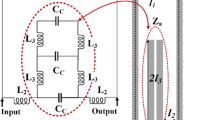Abstract
In order to resolve the problems that the Chinese mobile communication was facing (high dropped call rate, not so good voice quality, etc.), we developed a 20-pole high-temperature superconductor thin-film microstrip filter with steep band edges. This filter which had a quasi-elliptic type frequency response was designed for GSM-1800 base station receiver system. Its frequency ranged from 1711 MHz to 1789 MHz. It was fabricated using double-sided YBCO thin films on LaAlO3 substrate. The substrate size was 0.52 mm × 21 mm × 40 mm. Experiments were performed on a Stirling cooler at a temperature of 60 K. The measured insertion loss in the passband is below 0.35 dB, return loss is bigger than 13.5 dB, and the steepness of the band-edge is up to 18 dB/MHz. Then we assembled it with an LNA (low noise amplifier) into a vacuum chamber to get a base station receiver front end and measured it. Its measured gain is 22.5 dB, and noise figure is below 0.6 dB in the passband which is very important to improve the sensitivity of the base station system.
Similar content being viewed by others
REFERENCES
Chinese Ministry of Information Industries. MII Web site: www.mii.gov.cn
D. G. Smith and V. K. Jain, Superconducting filters for wireless communications: A reappraisal, IEEE Trans. Appl. Supercon. 9(2), 4010-4013 (1999).
J.-S. Hong, M. J. Lancaster, R. B. Greed, J.-C. Mage, and H. J. Chaloupka, A high-temperature superconducting duplexer for cellular base-station applications, IEEE Trans. Microwave Theory Tech. 48(8), 1336-1342 (2000).
J.-S. Hong, M. J. Lancaster, R. B. Greed, J.-C. Mage, and H. J. Chaloupka, On the performance of HTS microstrip quasi-elliptic function filters for mobile communications application, IEEE Trans. Microwave Theory Tech. 48(7), 1240-1246 (2000).
S. Kolesov, B. Aminov, H. Chaloupka, T. Kaiser, S. Kreiskott, H. Piel, N. Pupeter, R. Wagner, D. Wehler, H. Medelius, and Z. Draganic, Cryogenic BTS receiver front end demonstrator, Proc. 30th Eur. Microwave Conf. 3, 230-232 (2000).
W. Hattori, T. Yoshitake, and K. Takahashi, An HTS 21-pole microstrip filter for IMT-2000 base stations with steep attenuation, IEEE Trans. Appl. Sprercon. 11(3), 4091-4094 (2001).
I. B. Vendik, A. N. Deleniv, V. O. Sherman, A. A. Svishchev, V. V. Kondratiev, D. V. Kholodniak, A. V. Lapshin, P. N. Yudin, B. C. Min, Y. H. Choi, and B. Oh, Narrowband Y-Ba-Cu-O filter with quasi-elliptic characteristic, IEEE Trans. Appl. Sprercon., 11(1), 477-480 (2001).
Author information
Authors and Affiliations
Rights and permissions
About this article
Cite this article
Liu, BC., Cao, BS., Zhu, MH. et al. An HTS 20-Pole Microstrip Filter for GSM-1800 Base Stations. Journal of Superconductivity 16, 819–822 (2003). https://doi.org/10.1023/A:1026250817656
Issue Date:
DOI: https://doi.org/10.1023/A:1026250817656




